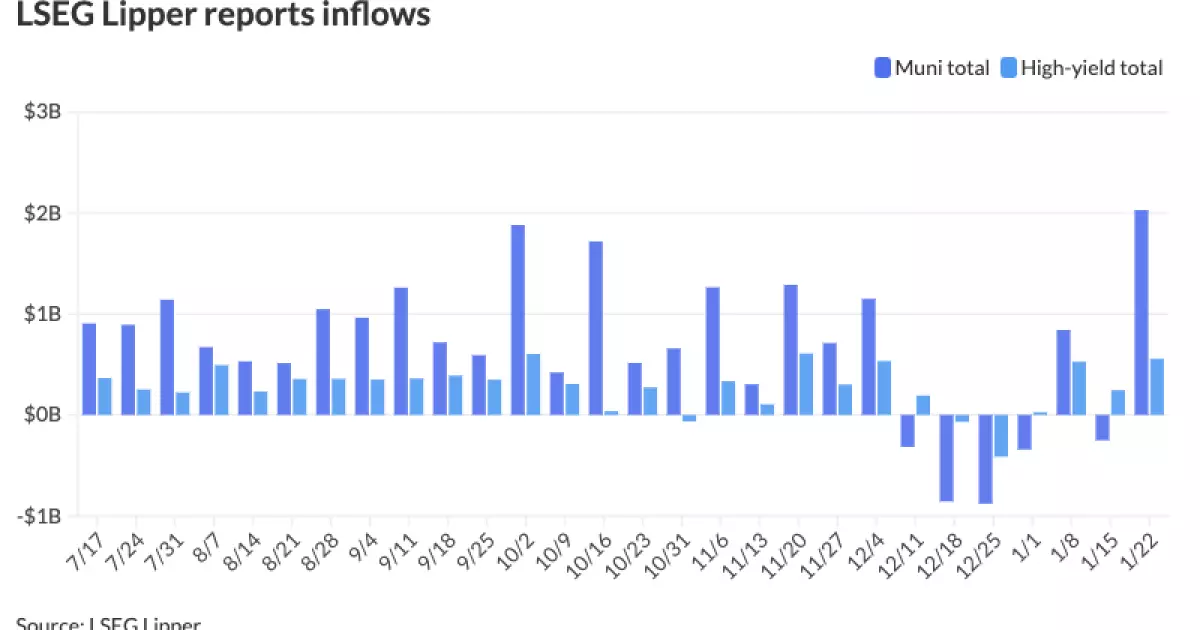With the municipal bond market exhibiting a complex interplay between supply and demand dynamics, a closer examination reveals a market that is not only grappling with challenges but also highlighting significant opportunities for investors. Recent market movements, including upticks in issuance, notable inflow trends in mutual funds, and varying yield patterns, underscore the evolving landscape of municipal finance.
On a seemingly uneventful Thursday, there was a noteworthy contraction in the municipal bond market, with municipal bonds exhibiting a weaker performance amidst a slowing primary market. The inflow of over $2 billion into municipal mutual funds illustrates investor confidence but simultaneously hints at underlying challenges. When juxtaposed with rising U.S. Treasury yields, particularly for longer durations, it becomes clear that investor sentiment is teetering between caution and opportunity.
Municipal bonds are typically characterized by their lower yields compared to USTs (U.S. Treasuries) due to the tax-exempt nature of their interest payments. However, the current municipal-to-UST yield ratios—64% for two- and five-year bonds, climbing to 83% for the 30-year sector—suggest an intriguing divergence between the two markets. Senior fixed income portfolio managers, such as Kim Olsan from NewSquare Capital, highlight a critical trend: despite lower redemptions and a larger issuance environment compressing yields, investors appear to be drawn to the tangible yield opportunities available in munis.
Heterogeneity in the quality of bond issues further complicates investor decisions. The high demand for the limited number of high-grade issuances on any given day fuels tighter spreads. For example, recent sales from Washington state and Nevada showcased spreads of just +7 to +10 over MMD (Municipal Market Data) in 10-year maturities—a stark contrast to wider spreads that prevail during periods of market uncertainty. This indicates that while the broader market might be leaning weak, specific segments continue to thrive, underscoring a landscape replete with selective investment opportunities.
The broader primary market is witnessing pricing shifts, particularly visible in higher-rated institutions. Notably, the recent pricing of bonds from the University of Maryland Medical System provided an illustrative example of how even lower-rated categories are exhibiting firm demand. Secure spreads demonstrated that even when dealing with potential risks associated with A-rated hospital bonds, investors are still attracted to higher DB yields paired with relatively tight spreads.
Analyzing investor behavior reveals a cautious yet distinct preference towards AAA and AA-rated credits, which have seen modest outperformance thus far in January. The last few weeks of trading have revealed narrower spreads for these categories, signaling that investors are placing a premium on quality, likely underpinned by ongoing fiscal policies and risk assessments.
Consumer trust in municipal bonds is further magnified as many investors tactically maneuver through a landscape replete with opportunities and risks. As Olsan notes, an evolving roster of fund products tailored towards municipal investments signifies a palpable demand for alpha beyond the realm of high-grade credits. As a result, investors are increasingly scrutinizing their strategies, favoring quality over quantity in determining allocation strategies amidst lower issuance levels.
The inflow trend into municipal bond mutual funds—totaling over $2 billion for the week—has sparked conversations about the underlying investor sentiment. This significant uptick follows a week of outflows, indicating a strong reversal in trend that can be seen as a notable signal for market dynamics. High-yield funds are particularly noteworthy, with inflows surging above $555 million, underscoring a growing appetite for riskier segments in a generally conservative investment climate.
In stark contrast, tax-exempt money market funds reported substantial outflows, contributing to a larger narrative of asset management strategies. The overall environment for municipal money market funds illustrates a divergence where investors are reassessing their positions based on changing yield landscapes. The rise in average simple yields for tax-exempt funds may provide additional incentives for investors looking to maximize returns on lower-rated bonds, illustrating a complex web of stakeholder expectations.
A thorough analysis of the current municipal bond market shows an environment ripe with opportunity yet clouded by intricate dynamics fueled by investor behavior, market sentiment, and liquidity concerns. With yields currently exhibiting signs of compression, investors must remain vigilant in identifying tactical opportunities that align with their risk profiles. As the landscape continues to evolve, the potential for both risk aversion and attractive returns remains, aiding in shaping both short-term and long-term strategies for navigating the municipal bond investment terrain.

